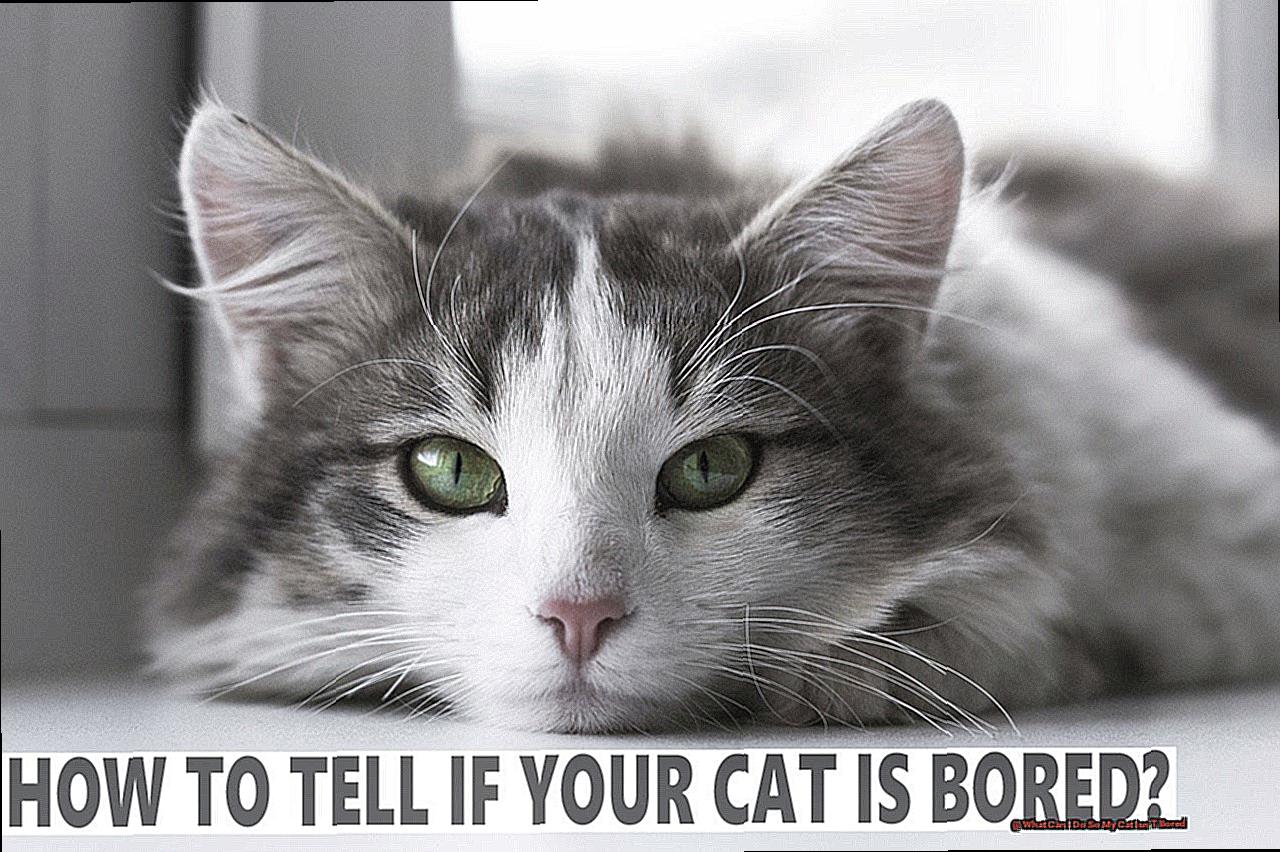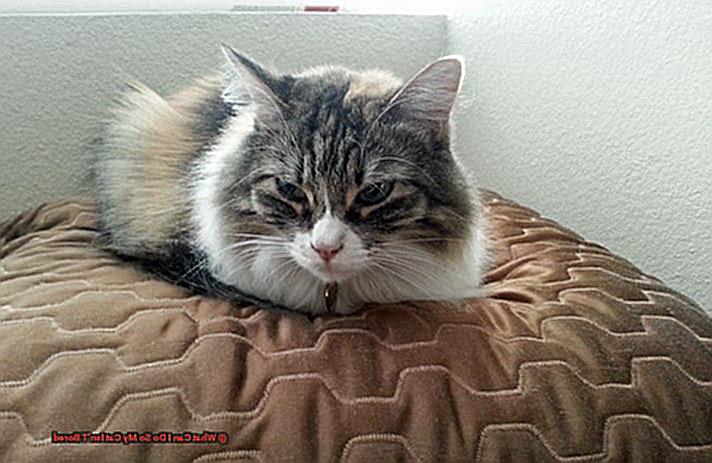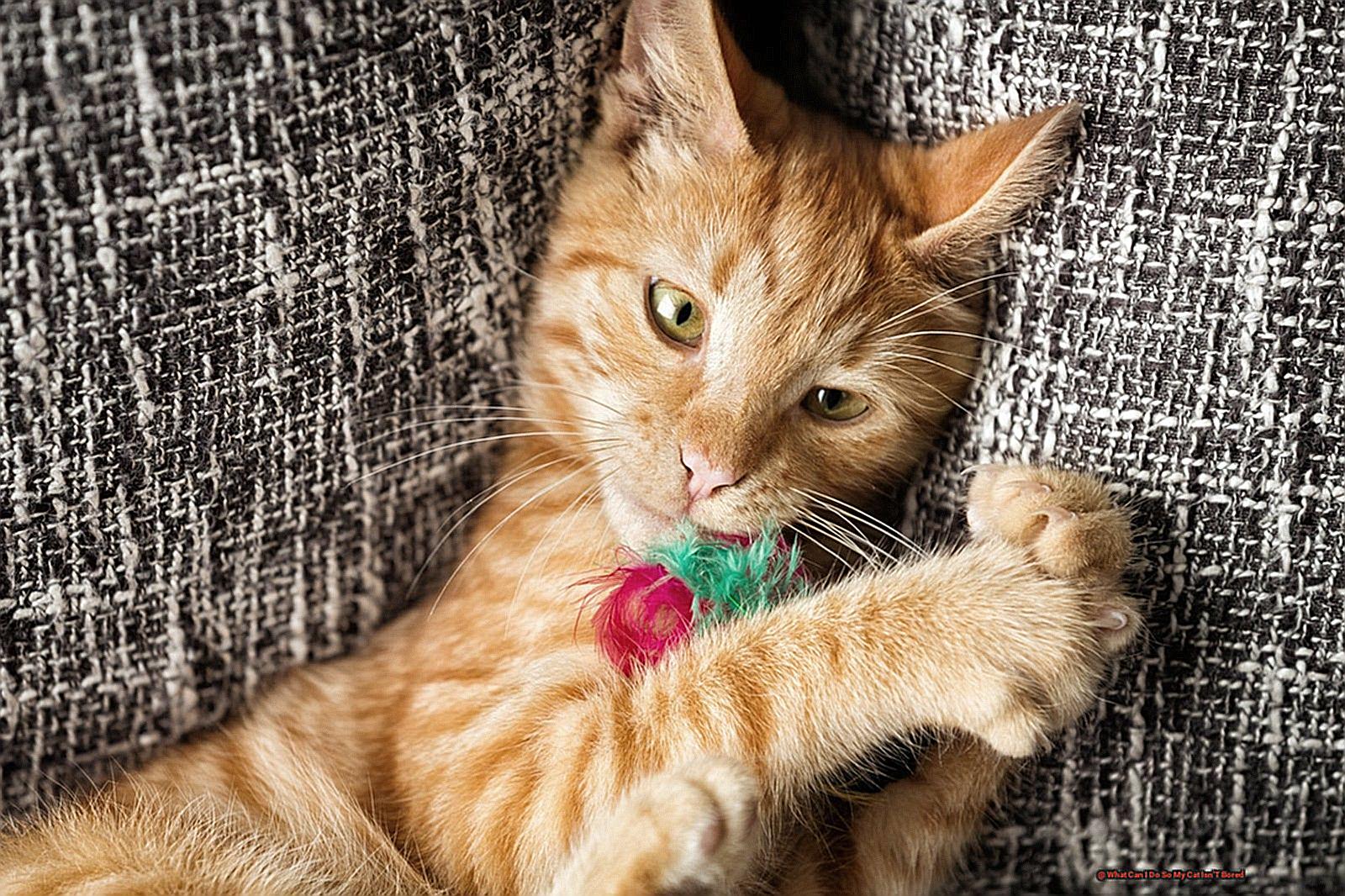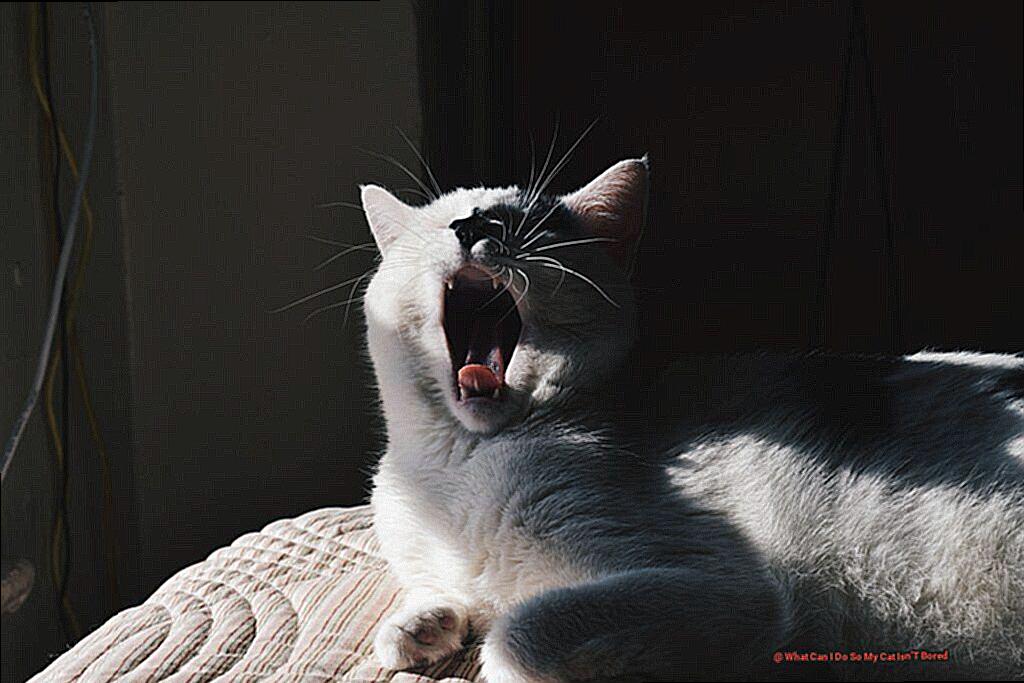Ever wondered why your cat spends hours staring out the window or swatting at a string?
Well, it’s because our feline friends need some serious mental and physical stimulation to stay happy and healthy. Bored cats can turn into little terrors, wreaking havoc on your furniture or scratching up your favorite rug.
So, what’s a responsible cat parent to do? Fear not.
In this blog post, we’ll dive into a whole bunch of activities, toys, and ideas that will keep your furry friend entertained and engaged. From mind-boggling puzzle toys to DIY play areas fit for a king or queen of the cat kingdom, these suggestions will not only provide mental stimulation but also promote exercise.
Get ready for some serious kitty fun that will keep your furball entertained for hours on end.
What can I do so my cat isn’t bored
To ensure their overall well-being and happiness, it’s important to provide them with ample mental and physical stimulation. Boredom can lead to behavioral issues or even health problems in cats. So, let’s explore some simple yet effective ways to keep your cat entertained and engaged.
Toys, Toys, Toys:
Cats are natural hunters, so providing them with toys that mimic prey is a great way to keep them mentally stimulated. Interactive toys like puzzle feeders or treat-dispensing toys are excellent choices. These toys not only engage their hunting instincts but also make mealtime more challenging and rewarding.
Create a Stimulating Environment:
Cats love to climb, scratch, and explore. Setting up a cat tree or shelves for climbing, providing scratching posts or boards, and offering hiding spots or tunnels are all fantastic ways to create a stimulating environment for your feline friend. This allows them to engage in natural behaviors while keeping boredom at bay.
Playtime for Bonding:
Dedicate at least 10-15 minutes each day for interactive play sessions with your cat. Use toys such as feather wands or laser pointers to encourage them to chase and pounce. Not only does this keep them physically active, but it also strengthens the bond between you and your feline companion.
Window Watching:
Cats are intrigued by the sights and sounds of the outside world. Set up a window perch or bird feeder outside the window so they can enjoy the entertainment nature provides. Watching birds or squirrels can be a great source of mental stimulation for your cat.

Rotate Toys Regularly:

Just like humans, cats can become bored with the same toys over time. To prevent this, rotate their toys every few weeks. Introduce new toys to keep their interest levels high and provide them with variety.
Enrich Their Environment:
Cats love different textures and scents. Use catnip or silver vine on their toys, or provide them with cat-friendly herbs like mint or valerian root. These scents can help keep them engaged and entertained. Additionally, consider providing vertical spaces, such as shelves or perches, for your cat to explore and claim as their own.
Safe Outdoor Experiences:
If it’s safe and feasible, consider creating a secure outdoor space for your cat to explore under supervision. A catio or an enclosed outdoor enclosure can allow your cat to experience the outdoors while ensuring their safety.
Consider a Companion:
If your cat is social, consider adopting another feline friend. Having a playmate can provide endless entertainment and companionship for both cats. However, ensure proper introductions and compatibility before bringing a new cat into your home.
Provide Your Cat with Variety of Toys to Stimulate Their Curiosity

One effective way to do this is by offering a variety of toys that engage their senses and keep them entertained. In this blog post, we’ll explore different types of toys that can captivate your cat’s curiosity and provide hours of fun.
Interactive Toys:
Puzzle toys are a fantastic choice for engaging your cat’s mind and encouraging problem-solving skills. These toys typically have hidden compartments where treats or small toys are concealed. By figuring out how to retrieve the hidden goodies, your cat will be mentally stimulated and rewarded for their efforts.
Feather Toys:
Feather toys are a tried-and-true favorite among cats. They mimic the movement of prey, triggering your cat’s hunting instincts. Attach a feather toy to a string or wand, and enjoy interactive play sessions with your feline friend. It’s a great way to bond and provide physical exercise.
Catnip Toys:
Catnip is like magic for most cats. Infusing toys with catnip can be highly stimulating and entertaining. The irresistible scent of catnip will attract your cat’s attention, leading to hours of playful antics. Remember to use catnip in moderation as some cats can become overstimulated.
Balls and Small Toys:
Cats love to chase and pounce on moving objects. Providing balls and small toys allows them to engage in natural hunting behaviors. Opt for toys that are lightweight and easy to bat around. Consider incorporating toys with bells or crinkly sounds for added excitement.
Rotation is Key:
To prevent boredom, it’s important to rotate your cat’s toys regularly. Cats can lose interest if the same toys are always available. By introducing new toys every few days, you’ll keep your cat engaged and excited. Keep a selection of toys handy and switch them out to provide a fresh experience each time.
Catering to Preferences:
Just like humans, cats have individual preferences. Experiment with different textures and materials to find what your cat enjoys most. Some cats prefer soft plush toys, while others may be captivated by crinkly or crunchy toys. Understanding your cat’s preferences can help you curate the perfect toy collection.
Safety First:
When selecting toys for your cat, prioritize safety. Avoid small parts that could be swallowed or sharp edges that could cause injury. Always supervise playtime to ensure your cat doesn’t accidentally ingest or get tangled in any toy strings.
Create a Stimulating Environment for Your Cat
Cats are fascinating creatures with their own unique personalities and preferences. They love to explore, play, and hunt, so it’s important to create a stimulating environment that satisfies their natural instincts. In this blog post, we will explore some tips and tricks to keep your feline friend entertained and mentally stimulated.
Climbing and Perching
Cats are natural climbers, so providing vertical spaces for them to explore is essential. Invest in a cat tree or install shelves on the walls that they can climb on. This not only gives them a chance to exercise but also allows them to observe their surroundings from a higher vantage point.
Interactive Toys
Toys play a crucial role in keeping your cat entertained. Choose interactive toys that mimic prey-like movements or have hidden treats inside. This will engage their hunting instincts and keep them entertained for hours. Puzzle toys are also great for challenging their problem-solving skills.
Variety is Key
Just like us, cats can get bored with the same toys over time. Rotate and introduce new toys regularly to prevent boredom. Keep a variety of toys available and switch them out every few weeks. This will keep your cat excited and engaged.
Hiding Spots and Cozy Spaces
Cats love hiding in small, enclosed spaces, so provide them with cozy hiding spots like cardboard boxes or soft beds. This gives them a sense of security and entertainment. You can even create DIY hiding spots using old blankets or towels.
Playtime with You
Nothing beats interactive playtime with your cat. Set aside dedicated play sessions where you engage with your furry friend using toys that encourage physical activity, such as wand toys or laser pointers. This not only provides exercise but also strengthens the bond between you and your cat.
Environmental Enrichment
Bring the outside world inside by adding window perches or bird feeders outside the window. Watching birds or squirrels can provide entertainment for your cat and stimulate their natural hunting instincts. Just make sure the window is secure and your cat cannot escape.
Spend Time Engaging in Interactive Playtime Sessions With Your Cat
Spend Time Engaging in Interactive Playtime Sessions With Your Cat
Interactive playtime sessions are not only a fun way to bond with your cat but also an essential part of their overall well-being. Cats have natural instincts to hunt and play, and providing them with interactive play sessions helps fulfill these needs. In this guide, we will explore the benefits of interactive playtime sessions and provide tips on how to make them enjoyable for both you and your furry friend.
Why Interactive Playtime Sessions Are Important
Interactive playtime sessions are crucial for keeping cats mentally stimulated and preventing boredom. When cats are bored, they may engage in destructive behaviors or exhibit aggression. By engaging in interactive playtime sessions, you can prevent these issues while also providing your cat with physical exercise.
Choosing the Right Toys
There are various interactive toys available that can make playtime sessions with your cat more engaging. Wand toys with feathers or strings are excellent options as they mimic prey and stimulate your cat’s hunting instincts. Laser pointers can create movement and encourage your cat to chase the light. Puzzle toys challenge your cat’s problem-solving skills, keeping their minds active and engaged.
Rotating Toys
To keep playtime sessions interesting for your cat, it is important to rotate and introduce new toys regularly. This prevents your cat from getting bored with the same toys and encourages them to stay engaged during playtime.
Setting Aside Dedicated Time
Make sure to set aside dedicated time each day for interactive playtime sessions with your cat. This ensures that they get enough mental stimulation and physical exercise. Aim for at least 15-20 minutes of playtime each day, but feel free to extend it if both you and your cat are enjoying yourselves.
Creating a Playful Environment

In addition to interactive toys, creating a playful environment for your cat can enhance their playtime experience. Provide climbing opportunities such as scratching posts or cat trees, cozy hiding spots like tunnels or boxes, and even bring the outside world inside with window perches or bird feeders. These elements will keep your cat entertained and mentally stimulated.
Let Your Cat Enjoy the World Outside
Cats are curious creatures by nature, and they often yearn for a taste of the world outside. But as responsible cat parents, it’s our job to ensure their safety while they indulge in their adventurous spirit. Here are some expert tips to let your cat enjoy the world outside while keeping them safe and sound.
Create a Secure Outdoor Space
Before unleashing your feline friend into the wild, make sure your yard is a safe haven for them. Check for any potential dangers such as toxic plants or other animals that may harm your cat. Installing a cat enclosure or building a catio can provide a secure and stimulating outdoor space for your furry companion.
Take Your Cat for a Stroll
Walking your cat on a leash can be an excellent way to let them experience the outdoors without putting them at risk. Start by getting your cat comfortable with wearing a harness indoors before venturing outside. Choose quiet and secure locations for your walks, and let your cat set the pace. Remember, it’s their walk, not yours.
Environmental Enrichment
Outdoor time should be more than just sniffing the breeze and chasing butterflies. Provide plenty of environmental enrichment in your outdoor space to keep your cat engaged and entertained. Scratching posts, climbing trees, and hiding spots will allow them to explore and play. Scatter food puzzles or toys around the area to encourage their natural hunting instincts.
Supervise, Supervise, Supervise
While outdoor adventures can be exhilarating for your feline friend, it’s crucial to supervise their outdoor time. Keep an eye out for any signs of distress or discomfort, and be ready to intervene if necessary. Extreme weather conditions or potential hazards should also be taken into consideration before letting your cat out.
Not All Cats Are Meant to Be Outdoors
It’s important to remember that not all cats are suitable for outdoor time. Cats with health issues or those prone to getting lost may be better off staying indoors. Don’t worry, though. Indoor-only cats can still lead fulfilling lives with plenty of mental and physical stimulation provided through playtime, interactive toys, and dedicated play sessions with their owners.
By following these expert tips, you can let your cat enjoy the world outside in a safe and supervised manner. So, go ahead and let your feline friend explore the great outdoors while keeping their safety and well-being a top priority. Happy adventuring.
Rotate Toys Regularly to Keep Interest Levels High
Cats are naturally curious creatures, and they thrive on new and stimulating experiences. One simple yet effective way to prevent boredom in cats is by rotating their toys regularly.
Why Rotate Your Cat’s Toys?
Cats can quickly lose interest in toys that they have been playing with for an extended period. Just like humans, they crave novelty and excitement. By introducing new toys and removing old ones from their play area, you can keep their interest levels high and prevent them from getting bored.
Variety is Key
When it comes to toys, variety is key. It’s essential to have a selection of different types of toys available for your cat. This includes interactive toys, puzzle toys, wand toys, and balls. Each type of toy offers a different type of stimulation and engages different senses, keeping your cat entertained and mentally stimulated.
Understanding Your Cat’s Preferences
Every cat has its own unique preferences and interests when it comes to toys. Some cats may prefer toys that mimic prey, such as feathers or toys that make squeaky sounds. Others may enjoy chasing small balls or batting at dangling objects. Observe your cat’s behavior and pay attention to what types of toys they seem most interested in.
How Often Should You Rotate Toys?
To keep your cat engaged, it’s best to rotate their toys on a weekly or bi-weekly basis. This means putting away some of their current toys and introducing a few new ones. By doing so, your cat will have a fresh set of toys to explore regularly.
Enhancing Toy Appeal with Scent Enrichment
Catnip and silver vine can be used as scent enrichment to make the toys more appealing to your cat. Sprinkling these natural herbs on the toys can enhance their allure and make them even more enticing for your feline friend.
Safety First
When selecting and rotating your cat’s toys, safety should always be a top priority. Choose toys that are suitable for cats, avoiding small parts that can be swallowed or sharp edges that can cause harm. Regularly inspect the toys for any signs of wear and tear, and replace them if needed.
By rotating your cat’s toys regularly, you can prevent boredom and keep them mentally stimulated. A variety of toys and introducing new ones periodically will ensure that your cat remains engaged and entertained, leading to a happier and healthier feline companion.
Enrich the Environment With Different Scents
Enrich the Environment With Different Scents for Your Feline Friend
Cats are known for their keen sense of smell, which plays a vital role in their overall well-being and mental stimulation. If you want to keep your furry friend entertained and happy, consider enriching their environment with different scents. Not only will this prevent boredom, but it will also provide them with much-needed mental enrichment. Let’s dive into some ways you can achieve this.
Using Cat-Friendly Essential Oils
One way to introduce scents to your cat’s environment is by using cat-friendly essential oils. However, it’s crucial to note that not all essential oils are safe for cats. Some can be toxic to them, so it’s essential to consult with a veterinarian before using any essential oils around your cat. That being said, there are some safe options that can have a calming effect on cats, such as lavender, chamomile, and valerian. These scents can help reduce stress and anxiety in your feline companion.
The Magic of Catnip
Catnip is a herb that contains nepetalactone, a compound that cats are highly attracted to. Introducing catnip into your cat’s environment can provide them with a stimulating scent that they’ll love. You can use catnip in toys, scratching posts, or even sprinkle it on their bedding to enhance their experience. Watching your cat play and roll around in blissful delight is sure to put a smile on your face.
Creating a Scent Garden
Why not create a scent garden specifically designed for your cat? Planting cat-friendly herbs such as mint, thyme, or rosemary can provide your feline friend with an outdoor sensory experience. These herbs release pleasant scents that cats enjoy exploring and rubbing against. Just make sure to create a safe and secure outdoor space for your cat to enjoy the scents without any potential hazards.
Interactive Toys and Puzzle Feeders
To provide both mental stimulation and olfactory enrichment, consider using interactive toys and puzzle feeders that release different scents as your cat engages with them. These toys are designed to keep your cat entertained, challenged, and mentally sharp. The variety of scents will keep their interest piqued, making playtime even more enjoyable.
Rotating Scents for Freshness
To prevent habituation and keep your cat engaged, make sure to rotate scents regularly. Introduce new scents periodically to keep their environment fresh and exciting. This can be as simple as changing the essential oils you use or adding different herbs to their scent garden. By keeping things interesting, you’ll ensure that your cat remains mentally stimulated and content.
Create a Safe Outdoor Space for Exploration
Letting them roam freely outdoors can be risky. That’s why creating a safe outdoor space for your cat is essential. In this guide, we’ll show you how to build an outdoor oasis that will keep your kitty entertained and protected.
Securing the Space:
Before anything else, ensure that the area is secure. Check for any openings or gaps in fences or barriers that your clever cat might squeeze through. Remove any toxic plants or potential hazards. Make sure there are no escape routes, such as loose boards or holes under fences.
Enclosed Outdoor Area:
Consider creating an enclosed outdoor space specifically designed for your cat’s exploration. Cat enclosures or screened-in porches provide a controlled environment where your kitty can experience the outdoors safely. They offer protection from predators and the risk of getting lost.
Elements of Enrichment:
To keep your cat engaged, incorporate various elements into the outdoor space:
- Climbing Trees and Vertical Spaces: Cats love to climb and observe their surroundings from high vantage points. Install tall scratching posts, cat trees, or even shelves where your kitty can exercise their natural climbing instincts.
- Hiding Spots: Create hiding spots using boxes or tunnels. These mimic the experience of hunting prey and add excitement to your cat’s outdoor adventures.
- Interactive Toys: Place puzzle feeders or treat-dispensing toys in the outdoor area to stimulate your cat mentally and physically. These toys simulate hunting behaviors and provide hours of entertainment.
Fresh Water and Shade:
Ensure your cat has access to fresh water and shaded areas in the outdoor space. Place a water bowl in a shaded spot to keep your kitty hydrated during playtime.
Supervision:
Regular supervision is vital when your cat is outside. Keep an eye on them to ensure they’re not engaging in risky behavior or encountering potential dangers. This also allows you to monitor their overall well-being and intervene if necessary.
Considerations:
Remember that not all cats may be suitable for outdoor exploration. Factors such as age, health, and temperament should be taken into account. Some cats may be perfectly content with indoor stimulation and may not require outdoor access.
Consider Adopting Another Cat as a Companion
Cats are social creatures, and many benefit from having a companion to keep them company and alleviate boredom. If you’re considering adopting another cat as a companion for your current feline friend, it’s important to approach the introduction process with care and consideration. Here’s a guide to help you successfully introduce a new cat into your household.
- Consider Your Current Cat’s Personality: Before bringing home a new cat, take into account the personality and temperament of your current cat. Some cats are more sociable and open to new companions, while others may be more territorial or independent. It’s important to choose a cat with a compatible personality to increase the chances of a successful introduction.
- Choose the Right Age: Kittens tend to adjust more easily to a new companion, as they are still in their socialization period and are more adaptable. Adult cats may require a longer adjustment period, especially if they have been the only pet in the household for an extended period of time.
- Match Energy Levels and Play Styles: It’s recommended to choose a cat that has a similar energy level and play style as your current cat. This will increase the likelihood of them getting along and enjoying each other’s company.
- Provide Separate Resources: To prevent territorial disputes, it’s crucial to provide separate resources for each cat. This includes separate litter boxes, food bowls, and sleeping areas. Cats are naturally territorial animals, so having their own designated spaces will help reduce potential conflicts.
- Gradual Introduction: Slowly introduce the new cat to your home by keeping them in separate rooms initially. Allow them to sniff each other under the door and swap bedding to familiarize themselves with each other’s scent. Gradually increase supervised interactions, always keeping a close eye on their behavior.
- Expect Some Initial Hissing: It’s normal for cats to exhibit some hissing or territorial behavior during the introduction process. This is their way of establishing boundaries and asserting themselves. As long as there is no aggressive behavior or physical harm, allow them to work through these initial challenges.
- Equal Attention and Playtime: It’s essential to give each cat plenty of attention and playtime to prevent feelings of jealousy or neglect. Spend quality time with each cat individually, ensuring they both receive love and affection.
- Patience is Key: Introducing a new cat takes time and patience. Every cat is unique, and the adjustment period can vary from a few weeks to several months. Be patient and allow them to set their own pace for bonding and establishing their relationship.
Also Read: Are Tortoiseshell Cats Hypoallergenic
Conclusion
To ensure your feline friend stays entertained and stimulated, there are several activities you can incorporate into their daily routine. First and foremost, interactive toys are a fantastic way to keep your cat engaged. From puzzle feeders to feather wands, these toys provide mental and physical stimulation that will prevent boredom from creeping in.
Another great option is to create an enriching environment for your cat. This can be achieved by setting up perches near windows so they can observe the outside world or installing shelves for them to climb and explore. Additionally, consider providing scratching posts or mats to satisfy their natural instinct to scratch while keeping your furniture intact.
Don’t underestimate the power of playtime with your furry companion. Regularly engaging in interactive play sessions using laser pointers, balls, or even homemade toys will not only keep them entertained but also strengthen the bond between you two.
Introducing variety into their surroundings is key as well. Cats love novelty, so try rotating their toys every few weeks or introducing new ones periodically. This will prevent them from getting bored with the same old toys and keep their curiosity piqued.
Lastly, consider incorporating a routine into your cat’s day-to-day life. Cats thrive on predictability, so having set meal times, play sessions, and designated quiet time will give them structure and help alleviate boredom.
By implementing these strategies and providing a stimulating environment for your feline friend, you’ll ensure they lead a happy and fulfilled life free from boredom.







